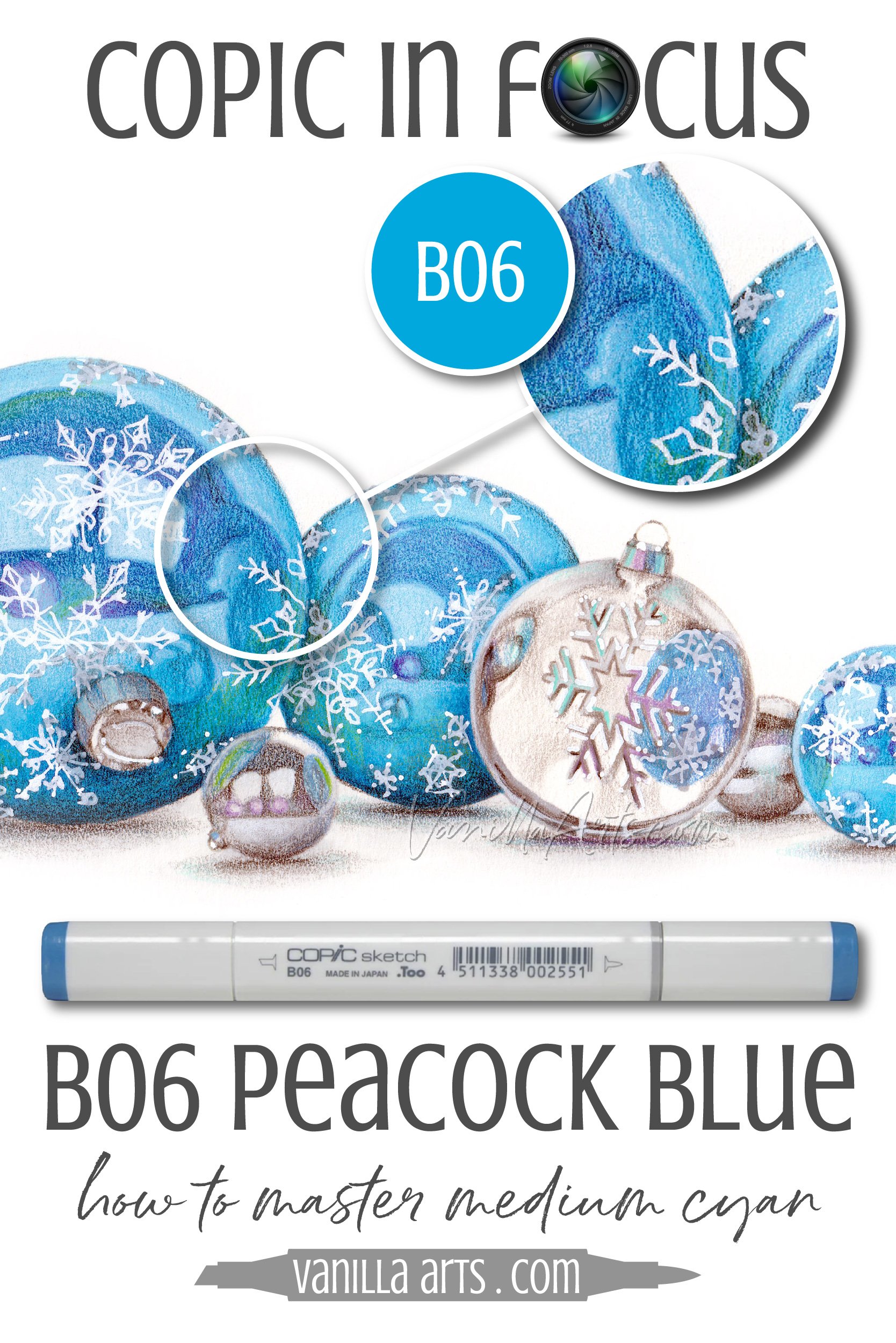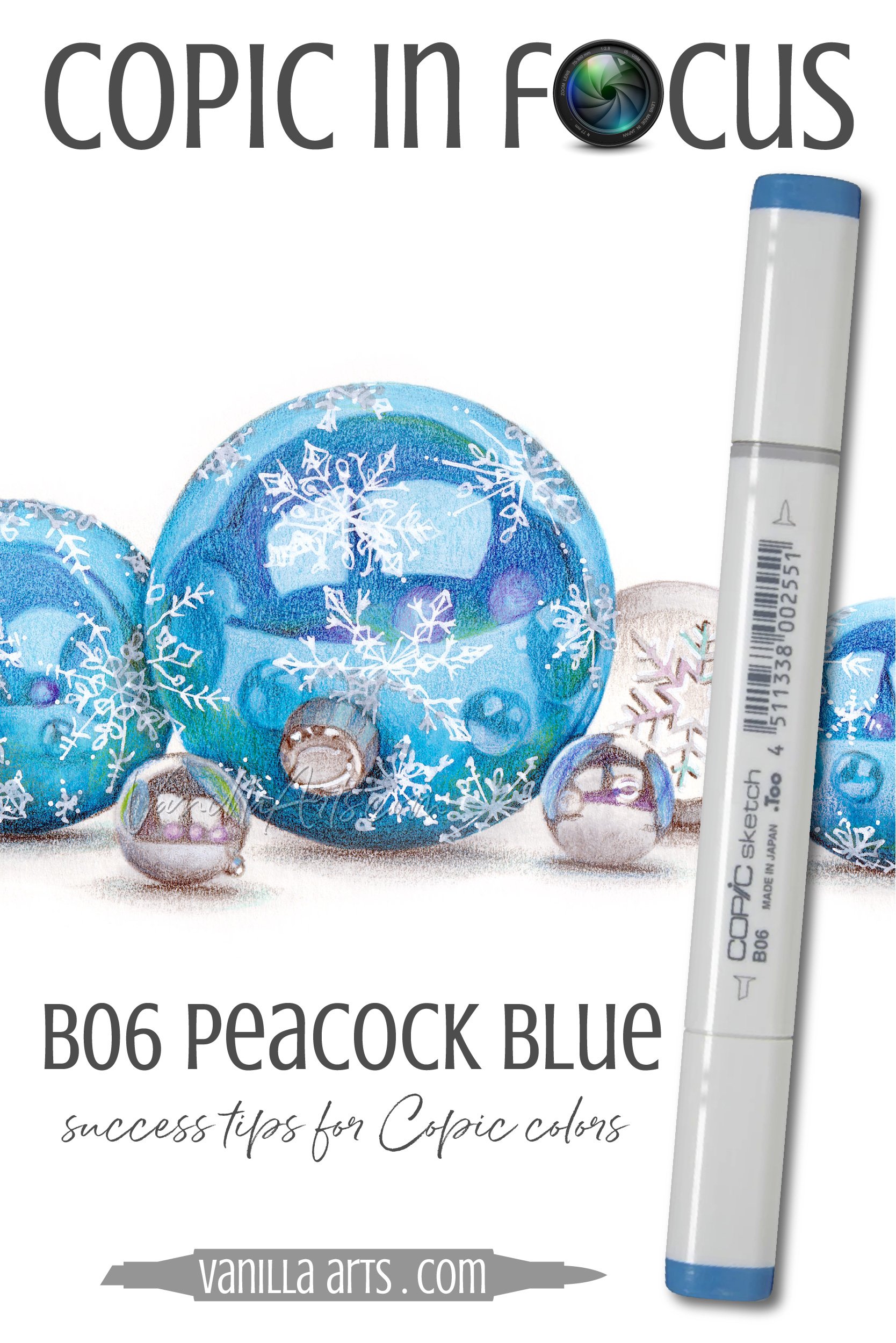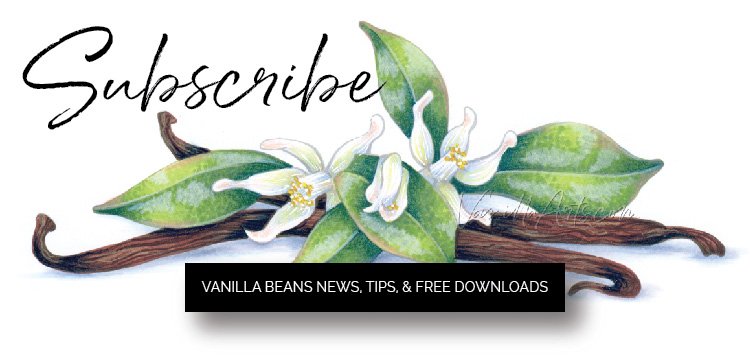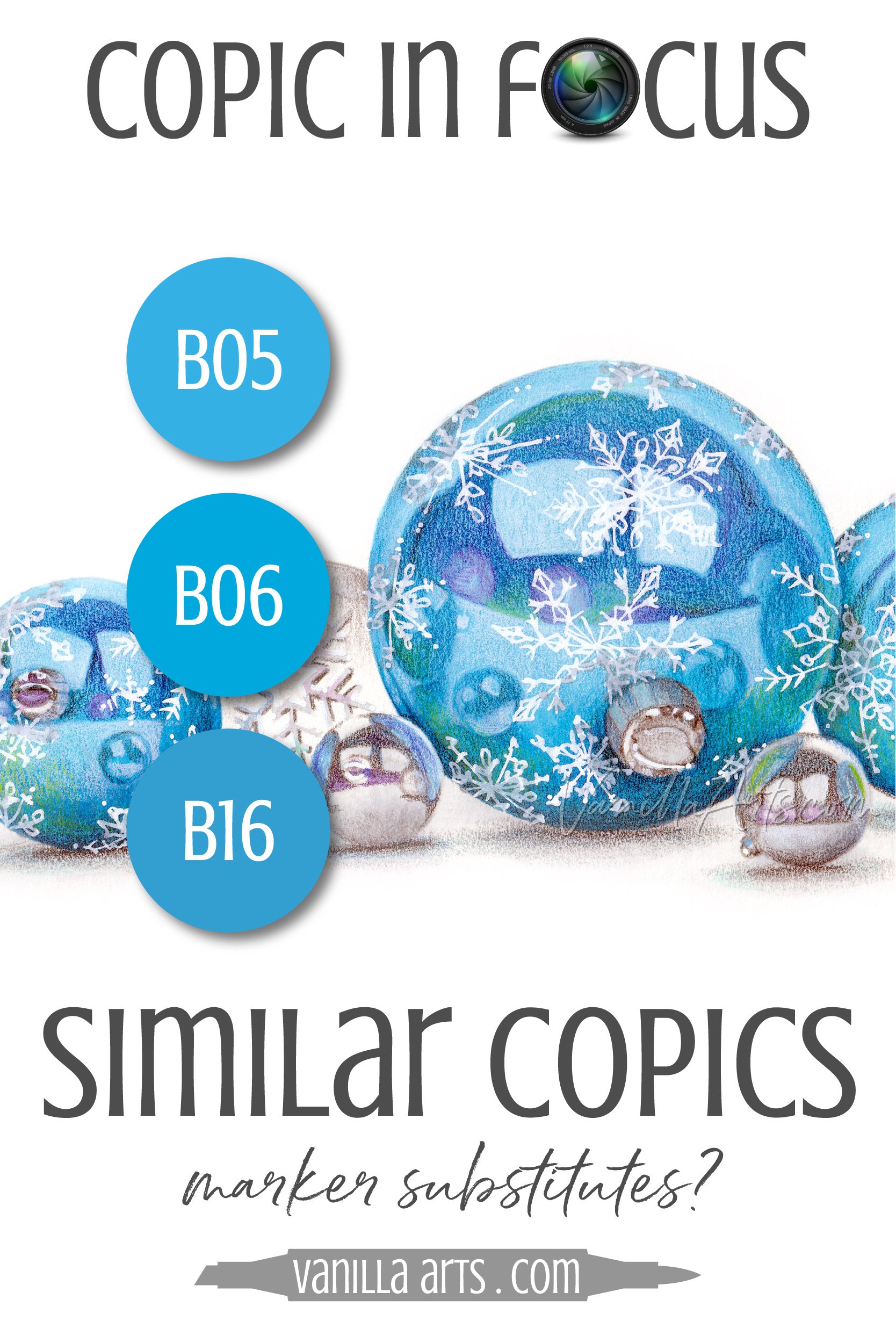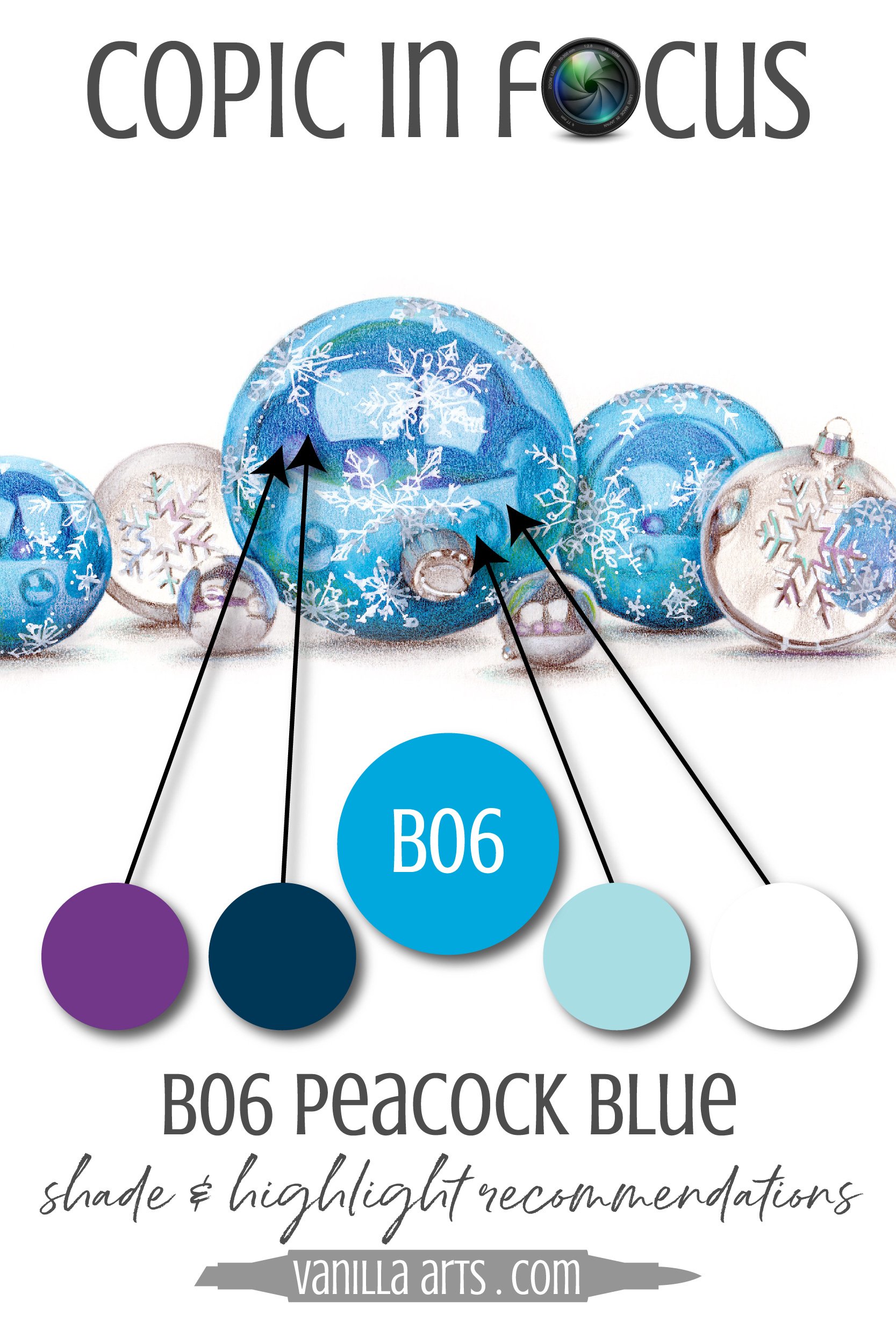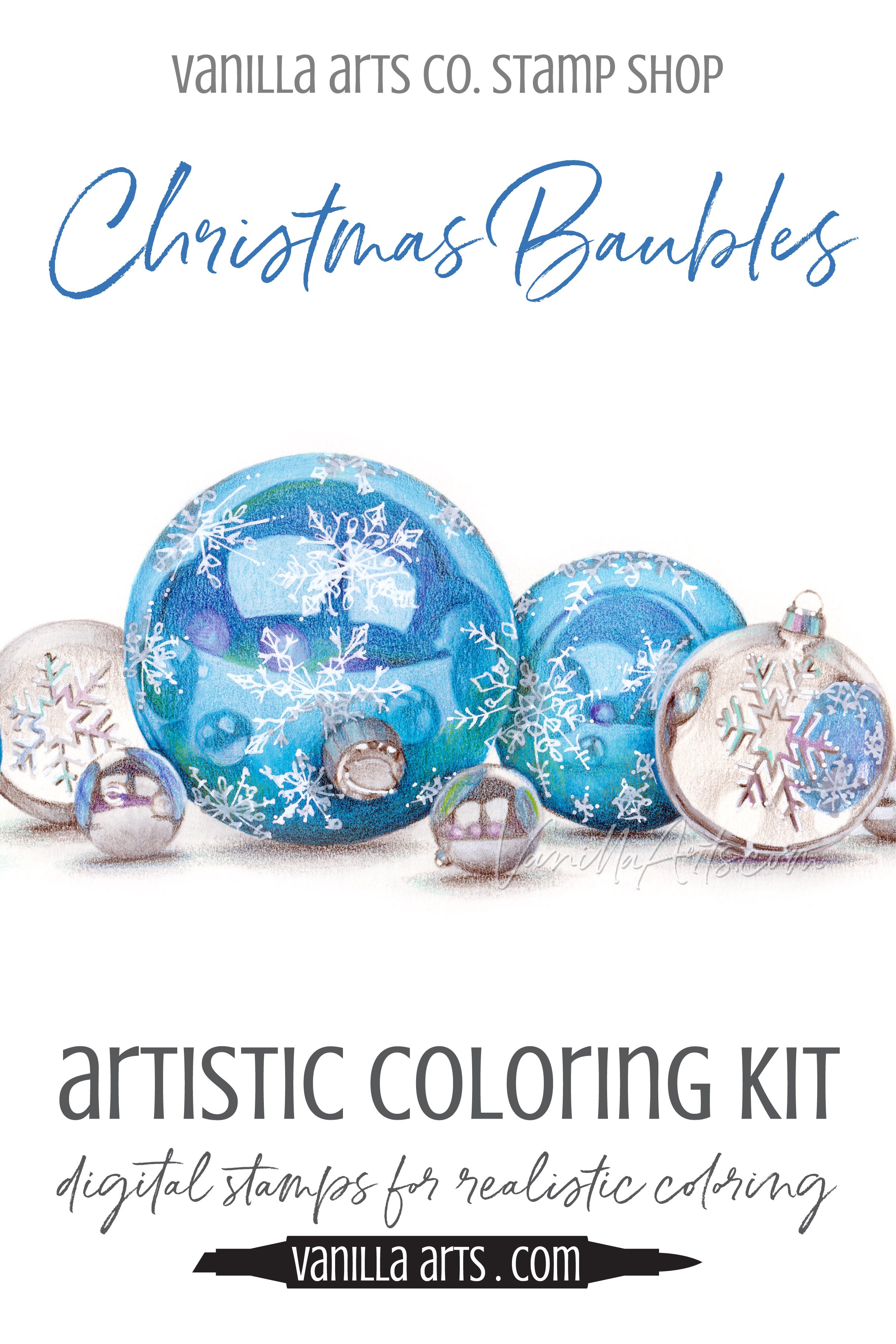Colors in Focus: B06 “Peacock Blue” Copic Marker (Everything you need to know and more)
What’s a Good Blending Combination for Copic B06?
At this point in my illustration career, I’ve worked with Copic Markers for almost 30 years. I know more than a few blue blending combinations.
But I’m always a little sad when someone asks me for a marker recipe.
Copic Markers can do so much more than blending!
To be honest, blending combos are the least of what we do.
Today, let’s look at Copic Marker B06 Peacock Blue from the artist’s perspective— how do I use this cyan marker in my classes and in my artwork?
Let’s get past the basic blending and find out how this marker really performs.
“Christmas Baubles” is an original line drawing by the author, Amy Shulke. This project is available as a coloring kit here and uses Copic Marker and Derwent Lightfast or Prismacolor Premier colored pencils.
Copic Marker B06 Peacock Blue is a bright, clean cyan color. It’s a very handy blue for general purpose coloring. We highly recommend this marker for beginners because it’s easy to blend and doesn’t shatter or look oily when over-worked.
Copic B06 Peacock Blue is the color of deep summer skies
If you asked ten people to describe their perfect blue, I’m sure several will have B06 in mind.
Yes, it’s a bright, summery cyan color but I also tend to associate B06 with the winter holidays, both Christmas and Hanukkah. This is a versatile color equally at home with snowy scenes as well as Caribbean color palettes
B06 is an cheerful color, full of clarity and warmth.
In the advanced level Christmas Baubles coloring kit project shown here, I’ve used a combination of B06-B04-B02 to basecoat the blue glass ornaments. Because B06 is such a clean color, it was easy to tint it warmer or cooler with either green or violet pencils. B06 is a chameleon cyan-blue which can take on any flavor you give it.
About the Color Family:
The B (Blue) family of Copic Markers is very large, especially when you add in their full range of blue-greens and blue violets. Copic clearly loves blue!
About the Ink Group:
B06 is part of the “Zero” group of B markers— the first number in the ID code tells you the group number. In general, Copics which start with 0 tend to be clear and bright… sometimes a little bit too bright to the point of florescence. We call this a “saturated hue” which means you can almost find these colors on a real rainbow.
Learn more about the Copic Numbering system in my article at MarkerNovice.com here.
About the Color Value:
The second number in the code B06 is a 6. This tells you that B06 is in the middle range of the Zero group (nine is the darkest while 0 is the lightest).
Copic makes many dark blue markers but the B-Zero family stops at B06. Even though it’s a medium blue, it’s the darkest marker in the Zero group. To create a deeper blue with B06, you’ll need to add a darker blue marker to the combination or underpaint B06 with something to strengthen it.
The B-Zero markers include— B06, B05, B04, B02, B01, B00, B000, and B0000.
Copic Blues are almost universally easy to blend with— this includes the BG and BV families. Blue inks rehydrate well which means you’ll have ample opportunity to fix a choppy blend, working it to smooth perfection.
B06 blends and layers beautifully. Because B06 is such a general blue color with an easy-blending nature, we highly recommend it as an early purchase for beginners. If you’re looking for a blue to practice your blending technique, B06 fits the bill perfectly. It works equally well as the light blue in a dark blending combination or the darkest blue in a lighter blend.
About the Name:
B06 is in the cyan family. Cyan is a color people call blue but it’s actually the name for the color halfway between blue and green (read more here). Cyan feels like a slightly greenish blue, even though it’s not truly blue.
The greenish feel to B06 likely inspired the name Peacock Blue.
The problem is that when most Americans or Canadians hear the name “Peacock Blue”, we associate it with something even greener, like turquoise or teal.
Copic names can be misleading and I suspect this could be because some names have been directly translated from the original Japanese. Perhaps “Peacock Blue” is bluer in Japan?
Is Copic B06 Ink Lightfast?
Does it fade quickly? Can it be erased? Does it shatter? Does the cap color match the ink color?
I’ve tested B06 ink to help you better predict how this ink will behave during use.
See the test results for:
Lightfastness
Layering
Color Build-up
Dilution
Value
Cap Accuracy
Behavior upon contact with Colorless Blender
MarkerNovice.com is the sister site to VanillaArts.com where I offer reliable information for Copic Marker beginners.
The Copics Uncapped series by Amy Shulke at MarkerNovice.com tests each marker for lightfastness, value, and various traits. You’ll color better with B06 when you understand how it behaves and what to expect.
How do I use Copic B06 Peacock Blue in Classes and Projects?
To be honest, I don’t teach with or use B06 very often.
I color a lot of food and florals; there’s not a lot of naturally occurring blues in my areas of focus. Sad but true.
But I really like B06 which is why I purposefully colored a Christmas image blue, just to enjoy the feeling of working with such a beautiful beautiful color.
I’ve taught a lot of online and local classes over the last decade— you can see many of my classes here in the Marker Painting Workshop. Shockingly, I was unable to find a single class which uses B06 aside from the Christmas Baubles coloring kit shown here.
I did use a similar background color in the Smiling Toucan project but it’s made with Distress Salty Ocean stamp ink with a touch of Peacock Feathers thrown in.
I find this very sad because I wear this kind of blue color a lot. By pure coincidence, I’m sitting here typing this article wearing a B06 sweater right now!
If you find a color repeated frequently in your clothing wardrobe, it’s a good bet you’ll know how to work with it in your art.
So I’m sitting here in my cyan blue sweater making a New Year’s resolution to use B06 Peacock Blue more often!
I usually use blue most as an underpaint color. B06 will be easy to fit into my normal routine but I’d also like to feature Peacock Blue more often, just as I did in this Christmas Baubles project.
Read More:
Click to visit articles about color theory and smart usage of color
How to Blend with Copic B06
Here are a few recommended blending combinations using B06.
Blending combinations for Copic Marker B06 Peacock Blue.
In the Self Blending swatch, I’ve created 3 layers of B06. The darker left side is three coats of ink, the middle mid-tone is two layers, and the far right is one layer of ink.
People don’t often think about blending a marker with itself but self-blending always creates the easiest gradient possible and a self combination always looks smooth.
I’ve sampled two natural blending groups for you. Actually, because they don’t make a B-Zero marker darker than B06, I had to fake the second natural blending combination.
A natural blending combination is 2-3 markers which all share the same first number.
The Natural Blend starts with B06 and moves to B04 and B02. I did notice the jump from B06 to B04 is slightly reluctant to blend. See the tips below for advice on how to make this transition smooth.
The Almost Natural Blend (Darker Blending Group) uses B99 and B18 to add a darker values to the combination. If Copic made B08 or B09, I think this is close to how they’d look in combination.
The last swatch is my favorite. I love blue-greens but I’m always a bit underwhelmed by the BG marker selection. They’re either too bright, too green, or too murky. By combining B06 with a BG marker and adding a gray to deepen the blend, I’ve created a very organic looking aquamarine blending combination.
Tips for blending B06:
As I mentioned above in the Natural Blend advice, I had a few issues getting B06 to blend smoothly with B04. Jumping from a level 6 marker to a level 4 usually isn’t a problem but it took me three tries to get the Natural swatch smooth. A solution would be to add B05 to the combination. I hate adding extra markers to any blend but in this case, if you’re looking for super-smoothness, try B06/B05/B04/B02.
As demonstrated in the swatch testing of B06 here, this ink is actually darker than a value level 6 marker should be. B06 should be called B07. This explains why adding B05 helps. Keep this extra darkness in mind when creating your own blends with B06.
B06 looks extremely streaky with just one layer. If you’re coloring something solid B06 without any blending, be prepared to use 3 layers of ink for maximum smoothness. See the layering test for B06 here for a glimpse at how many layers are necessary for it to look smooth by itself.
Don’t have B06 in your Copic Marker collection? We suggest these substitutions. They’re close in value and hue and could pass for Copic’s Peacock Blue in blending combinations.
Marker substitutes for Copic B06 Peacock blue
For the most part, Copic does a good job of not releasing markers which are too similar to existing colors.
But when you make 358 markers, there’s bound to be some overlap.
Are there similar colors B06 and can they be used as substitutes?
Yes… and no.
Here I’m showing you the two closest blues to B06 (the middle swatch).
B05 Process Blue is very close to B06. It’s a bit paler but the two markers are only 1 value level off from each other. I’m sure in a blending combination, this difference won’t be noticeable.
B16 Cyanine Blue is the same value as B06. B16 feels a bit bluer and slightly murkier than B06 (which has a bit of a glow). In fact, if you’re looking for a more natural, organic version of B06, I’d use B16.
Side by side, the differences between the three markers are very subtle.
But remember, just because the colors are similar does not mean these markers behave the same way! B16 uses a totally different ink formula. Every formula has unique blending characteristics.
Shade and Highlight Suggestions for B06 Peacock Blue
If you’ve read many articles here at VanillaArts.com or taken any of my classes, you know I teach an underpainting method.
In underpainting, we choose opposite colors on the color wheel to add the realistic murkiness found in real-life shade. We “desaturate” with complementary colors. Read more in my article series here.
We shade Copic Marker B06 Peacock Blue with colored pencils ranging from dark violet to indigo blue. We highlight it with soft aqua or white.
After I underpaint and blend with Copics, I come back with colored pencils to boost the shade and add highlights. My pencils rarely match the Copics.
Shade suggestions for B06 Peacock Blue:
Copic Underpaint— N5, C5, T5, V15, or BV04.
Prismacolor Pencil Overpaint: PC932 Violet, PC132 Dioxazine Purple Hue, PC901 Indigo Blue, or PC133 Cobalt Blue.
Highlight suggestions for B06 Peacock Blue
For maximum control, I prefer to highlight Copics with colored pencils rather than adding lighter markers to a blending combination.
Prismacolor Pencil Overpaint: PC938 White, PC1023 Cloud Blue. or 1086 Sky Blue Light.
The most important tip for working with Copic B06 Peacock Blue
And really, this advice holds true for working with all blue markers…
Blue isn’t just blue— there are warm blues and cool blues. Mixing warms and cools can lead to accidental muddiness.
Not enough Copic instructors teach this in classes, videos, or tutorials.
Maybe because they don’t pay attention to temperature either?
Our best tip for using Copic Marker B06 Peacock Blue is to keep in mind that there are many temperatures of blue. Trying to blend a warm blue with a cool blue can lead to dull or muddy colors instead of beautiful vibrance.
Copic makes a lot of blue markers, the span from BG to B to BV has more markers than any other color.
This gives you a ton of blending options for any blue situation.
But you must always note the temperature of the blues you’ve selected.
BG markers have green in the mixture, this is obvious from the BG designation on the cap. BGs are green-shift blues. It’s important to understand that B-Zeros, B-Teens, and B52 also have a green shift.
BV markers have a bit of violet (or more correctly, more magenta) in their mixture. These are red-shift blues. It’s important to remember that B-Twenties, B-Thirties, B-Forties, B-Sixties, B-Seventies, and B-Nineties also have a red shift.
When you blend a red-shift blue with a green shift blue, you cause a temperature imbalance.
I know you’ve seen this before, trying to blend two blues and you get something less vibrant and exciting than you expected.
Red + green = mud
Sometimes I mix red-shift blues with green-shift blues specifically because they neutralize each other, creating a more organic look.
But if you’re not expecting it, crossing a red with a green can be a shock. I’m not saying that it’s ugly or even super noticeable… but a lot of hobbyists choose Copic for their bright, vibrant colors. So accidentally creating a dull blend can make you wonder what you did wrong.
Is Copic B06 a Good Marker for Beginners?
Here’s the problem, there are sooooo many Copic blues…
So it’s hard to pick one best blue blending combination for beginners.
“Christmas Baubles” is an original line drawing by the author, Amy Shulke. This project is available as an artistic coloring kit here using Copic Marker and Derwent Lightfast or Prismacolor Premier colored pencil.
B06 is a very pretty blue which happens to be an easy-to-blend marker.
So it’s not a bad choice for a starter blue.
And yet I’m hesitant to say this should be your FIRST blue purchase.
There’s nothing wrong with B06, the problem is that Copic doesn’t make B07, B08, or B09.
B06 is a medium blue— you can’t color for very long without a dark blue in your collection.
This is why I tend to recommend the B-Twenties or B-Nineties as starter blues. The 20s and 90s have a larger selection of light to dark markers in their respective groups.
B06 shouldn’t be the first blue you purchase but if you like cyan, B06 should be an early addition to your growing collection.
Read more about my starter set with tips for building your marker collection in my article here.
Learning Resources for Copic B06 Peacock Blue
See B06 in action:
Use our Vanilla Undercover swatches to add realistic depth and shade to your next coloring project.
There are no current swatches with B06 but we publish new swatches every Thursday.
Vanilla Undercover is sponsored by Violeta-Ink.com
Vanilla Arts Online Classes & Kits using B06 or similar cyan color palettes:
(Click for more info)
Complex reflections
Create lifelike mirror effects while you develop your own artistic voice.
Christmas Baubles
Artistic Coloring Kits are everything you need to challenge yourself with intermediate to advanced level images.
Use your color sculpting and rendering reflections skills to create realistic Christmas Baubles!
Let your skill & creativity be the star of the image, not the stamp art. Ideal for large-scale projects in Copic Marker, colored pencil, or watercolor
Kit includes: digital stamp, suggested supply list, photo references, guide to shade and shadow & underpainting advice, color map & coloring process tips & photo collage
Select supplies used in Christmas Baubles:
Vanilla Arts Company is a participant in the Amazon Services LLC Associates Program, an affiliate advertising program designed to provide a means for use to earn fees by linking to Amazon.com.




